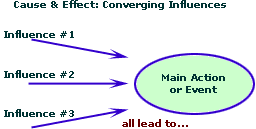Background on Cause & Effect
 Sometimes you want to figure out what made something happen or how something works. Either way, you're looking into the causes (what made something happen) and the effects (the thing that happen).
Sometimes you want to figure out what made something happen or how something works. Either way, you're looking into the causes (what made something happen) and the effects (the thing that happen).
 Sample topics could be almost anything. The point is, we want to learn about either what made the thing happen or how that thing works. Cause and effect analysis is all about studying how one thing impacts another. So it's the cause - effect, push - pull, input - output, give - take, of one thing influencing or acting upon another that we are interested in.
Sample topics could be almost anything. The point is, we want to learn about either what made the thing happen or how that thing works. Cause and effect analysis is all about studying how one thing impacts another. So it's the cause - effect, push - pull, input - output, give - take, of one thing influencing or acting upon another that we are interested in.
For the purposes of "Little Rock 9, Integration 0?," you're asked to consider things like: "What made people come to honor The Little Rock Nine?" or "How is the Magnet school integration strategy supposed to work?"
Getting to Work
- List or cluster around the topic you're analyzing (i.e., changing viewpoints on the Little Rock Nine or how a particular integration strategy is supposed to work). Take about ten minutes to brainstorm as many ideas and issues as you can recall from your research.
- Look for an order of events or influences
. The idea is that there are two main ways to do a Cause & Effect analysis: Chain of Events or Converging Influences.Use the graphics below to help you see if a series of actions created a chain of events or whether influences converged to make something happen or work. These two models are used to help you analyze your topic. Don't let them confuse you!

You can think of the "Chain of Events" as a "domino effect:" one thing impacts another, which causes another, and another, until you're at the final outcome (the thing you're analyzing). People have used this approach to describe the events that led to U.S. involvement in World War II or the Vietnam War.

You can think of "Converging Influences" as a "cooking recipe:" many ingredients come together to make a final product. All the ingredients are needed and if you change any one of the ingredients, you change the end product. People have used this approach to describe the cultural changes of the 1960s and how environmental changes impact ecosystems.
- Put your ideas to work
. When you can find 2 - 3 influences or actions that caused or effect your topic, you're ready to return to the Scaffolding page for Cause and Effect and fill in the form.Notice that this is not an easy process and you will probably feel confused at times. This is a natural part of thinking new thoughts. Feel free to ask your teacher or peers for feedback on your ideas.

Return to the Main Page
Created January, 1999
By Tom March,
Applications Design Team/Wired Learning